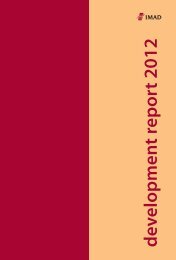Gonzalo C. Caprirolo and Marko Glažar Fiscal multipliers ... - UMAR
Gonzalo C. Caprirolo and Marko Glažar Fiscal multipliers ... - UMAR
Gonzalo C. Caprirolo and Marko Glažar Fiscal multipliers ... - UMAR
Create successful ePaper yourself
Turn your PDF publications into a flip-book with our unique Google optimized e-Paper software.
Working Paper 2/2013<br />
<strong>Fiscal</strong> <strong>multipliers</strong> <strong>and</strong> policy mix during fiscal consolidation process: minimizing the impact<br />
of fiscal adjustment on economic activity (GDP)<br />
9<br />
CONSOLIDATION’S ALTERNATIVE POLICY MIXES<br />
16. Consolidation can be achieved by means of different policy mixes (e.g. government expenditure<br />
reduction <strong>and</strong> revenue increases) <strong>and</strong> with different speed. If pursued alone by spending<br />
reduction this means a permanent expenditure reduction equivalent to 5 % of GDP whose<br />
implementation should be distributed over a given time frame with same or different intensity<br />
of the reduction of expenditure. In addition consolidation can also include tax rate increases<br />
which can contribute to mitigate the recursive use to expenditure reduction measures.<br />
17. To assess different consolidation alternatives (i.e. policy mix) <strong>and</strong> possibilities to minimize the<br />
impact on GDP given ongoing deleveraging in the economy <strong>and</strong> low external dem<strong>and</strong> the<br />
impact of various policy measures were simulated. These include: i) four-year consecutive<br />
permanent reduction of government consumption by 1 p.p. of GDP every year; ii) four-year<br />
consecutive permanent reduction of social transfers to liquidity constraint households by 1 p.p.<br />
of GDP every year 6 ; iii) three-year consecutive permanent reduction of government investment<br />
by 1 p.p. of GDP every year <strong>and</strong> 7 ; iv) one-time permanent increase in VAT rate by 2 p.p.<br />
equivalent to increase in government revenue by 1 p.p. of GDP. To assess the impact of<br />
consolidation versus no consolidation scenario a three-year consecutive increase in cost of<br />
capital by 100 bps was simulated.<br />
18. Figures 8 <strong>and</strong> 9 highlight the issue that the no consolidation scenario (IK) is the worst option for<br />
the economy in terms of GDP dynamics. They also implicitly indicate the risk associated with<br />
change in borrowing conditions for the government <strong>and</strong> the economy at large. Notice that the<br />
combined effect of consolidation on GDP by adding the effects of cutting of government<br />
consumption <strong>and</strong> transfers <strong>and</strong> increase in VAT rate is less negative than the increase in cost of<br />
borrowing. This suggests the importance of frontloading the adjustment when risk of increase<br />
in government borrowing cost is imminent (e.g. change in the sovereign credit rating) or<br />
government funding conditions worsen. It also indicates that when that risk is high the choice<br />
of instrument for consolidation is not too relevant as the losses from changes in borrowing<br />
conditions are larger.<br />
19. When looking at the issue of minimizing the cost of fiscal adjustment it is clear that a permanent<br />
increase in VAT has the smaller cost in GDP over the medium term. This is the case not only<br />
because its cost is the lowest in terms of accumulated GDP losses (Figure 10) but also because it<br />
reduces permanently the deficit gap <strong>and</strong> reduces the need to resort to successive cuts in<br />
expenditure which has larger GDP costs. However, resorting to VAT rate cannot be seen in<br />
isolation from other measures but as an accompanying policy measure as one time permanent<br />
increase in VAT rate while reducing permanently the deficit it cannot close the fiscal gap. For<br />
this purpose it is important to simultaneously reduce government expenditure (i.e. the<br />
consolidation has to be primarily led by expenditure cuts) <strong>and</strong> increase the VAT rate.<br />
20. An issue concerning changes in VAT rate it is the likely impact on inflation, wages <strong>and</strong> economic<br />
activity in general. In the model the increase in VAT rate transmits almost entirely into prices<br />
6<br />
The size of social benefits in cash <strong>and</strong> kind as percentage of GDP will be reduced from 20.1% at the end of 2011 to<br />
16.1 % of GDP which is close to the level in 2007.<br />
7<br />
The starting level of investment in GDP (2011) is 3.7 p.p. This implies that government investment cannot be<br />
reduced permanently beyond 3 years by 1 p.p. of GDP consecutively.

















